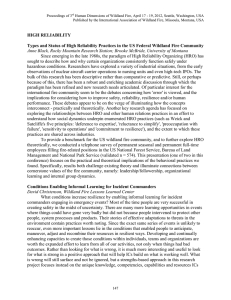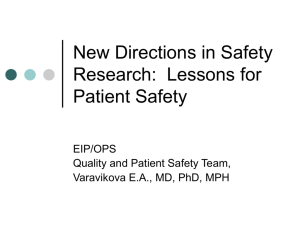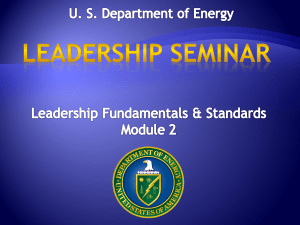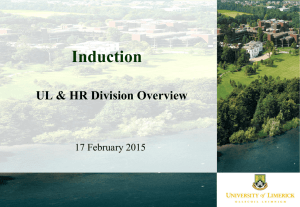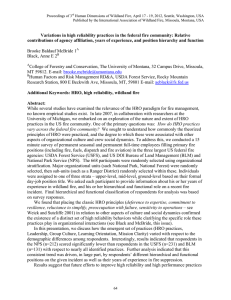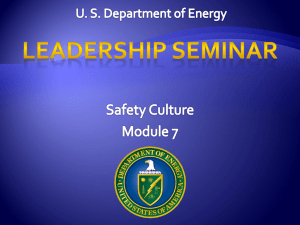High Reliability Organizing Implementation at Sequoia and Kings Canyon National Parks Background
advertisement
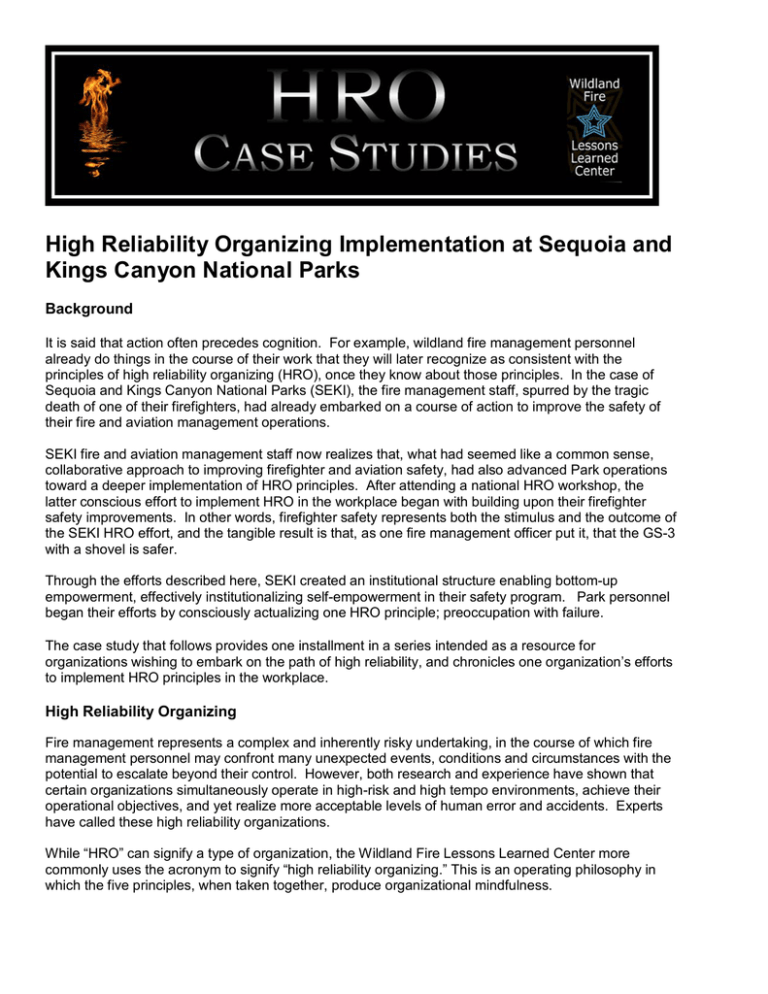
High Reliability Organizing Implementation at Sequoia and Kings Canyon National Parks Background It is said that action often precedes cognition. For example, wildland fire management personnel already do things in the course of their work that they will later recognize as consistent with the principles of high reliability organizing (HRO), once they know about those principles. In the case of Sequoia and Kings Canyon National Parks (SEKI), the fire management staff, spurred by the tragic death of one of their firefighters, had already embarked on a course of action to improve the safety of their fire and aviation management operations. SEKI fire and aviation management staff now realizes that, what had seemed like a common sense, collaborative approach to improving firefighter and aviation safety, had also advanced Park operations toward a deeper implementation of HRO principles. After attending a national HRO workshop, the latter conscious effort to implement HRO in the workplace began with building upon their firefighter safety improvements. In other words, firefighter safety represents both the stimulus and the outcome of the SEKI HRO effort, and the tangible result is that, as one fire management officer put it, that the GS­3 with a shovel is safer. Through the efforts described here, SEKI created an institutional structure enabling bottom­up empowerment, effectively institutionalizing self­empowerment in their safety program. Park personnel began their efforts by consciously actualizing one HRO principle; preoccupation with failure. The case study that follows provides one installment in a series intended as a resource for organizations wishing to embark on the path of high reliability, and chronicles one organization’s efforts to implement HRO principles in the workplace. High Reliability Organizing Fire management represents a complex and inherently risky undertaking, in the course of which fire management personnel may confront many unexpected events, conditions and circumstances with the potential to escalate beyond their control. However, both research and experience have shown that certain organizations simultaneously operate in high­risk and high tempo environments, achieve their operational objectives, and yet realize more acceptable levels of human error and accidents. Experts have called these high reliability organizations. While “HRO” can signify a type of organization, the Wildland Fire Lessons Learned Center more commonly uses the acronym to signify “high reliability organizing.” This is an operating philosophy in which the five principles, when taken together, produce organizational mindfulness. HROs know that our expectations can get us into trouble unless we create a mindful infrastructure that continually does all of the following activities: · Tracking small failures · Resisting oversimplification · Remaining sensitive to operations · Maintaining capabilities for resilience · Taking advantage of shifting locations of expertise The principles described in Figure 1 are five hallmarks of the operating practices found in organizations that operate in risky environments yet persistently have fewer accidents than one might expect. These organizations mobilize their organizational resources and execute their work dynamically, implementing the five principles of mindfulness continuously. Perhaps most importantly, HROs anticipate unexpected events and human error and act quickly to contain both. However, it is evident that the SEKI fire and aviation program is making progress on all five principles, most notably sensitivity to operations and deference to expertise. HROs are organizations that create a mindful infrastructure that manages activities according to five organizing principles: 1. Preoccupation With Failure. HROs treat any lapse as a symptom that something may be wrong, something that could have severe consequences if several separate small errors happened to coincide and weak signals of possible larger failures …HROs encourage reporting of errors, they elaborate experiences of a near miss for what can be learned, and they are wary of the potential liabilities of success, including complacency, the temptations to reduce margins of safety, and acting on autopilot. 2. Reluctance To Simplify. Resisting the common tendency to oversimplify explanations of events and to steer away from evidence that disconfirms management direction or suggests the presence of unexpected problems. 3. Sensitivity To Operations. Maintaining situational awareness and the big picture of current operations. Integrating information about operations and performance into a single picture of the overall situation and operational performance. Sensitivity to operations permits early problem identification, permitting action before problems become too substantial. 4. Commitment To Resilience. Recognizing, understanding and accepting that human error and unexpected events are both persistent and omnipresent. Assuming the organization will eventually be surprised; and developing the capacity to respond to, contain, cope with, and bounce back from undesirable change swiftly and effectively. 5. Deference To Expertise. The loosening of hierarchical restraints and enabling the organization to empower expert people closest to a problem, often lower­level personnel, when operational decisions must be made quickly and accurately. Shifting leadership to people who currently have the answer to the problem at hand. These principles represent a blend of organizational alertness, flexibility, and adaptability. They also represent a combination of anticipation and containment. A well functioning HRO also engages in continuous learning, and the five principles outlined above serve as conditions for that learning. In this way, HROs update their system, improve their knowledge, and see learning as an inseparable part of their everyday work. Figure 1. 2 Notable Successes That Others May Learn From Lesson Learned: Take a Collaborative Approach to Implementing HRO SEKI took a collaborative approach to implementing HRO by reaching both broadly across, and deeply into their fire and aviation management organization. The Fire and Aviation Program’s Safety Committee lies at the heart of the effort. “Single digit GS” employees comprise the Committee, with only one, ex­officio. advisor above the grade of GS­9 participating. Every module in the Park’s fire management organization contributes a representative to the Committee, and the modules each select their representative. SEKI Fire and Aviation Safety Committee Charter 2008 Besides improving firefighter safety, this approach to implementing HRO principles created a healthy, collaborative organizational climate that, in turn, improved job satisfaction and employee retention. SEKI fire and aviation management personnel gain expertise both in HRO and organizational learning. In addition, by empowering people “at the pointy end of the spear,” those people organize their own work, which creates a sense of collective ownership of the entire system. Consequently, people find their workplace empowering and want to work in the SEKI fire and aviation organization. Lesson Learned: HRO Implementation Built on a Foundation of Learning and Improvement The SEKI HRO implementation effort rests on a foundation of organizational learning and continual improvement. For example, the SEKI fire management safety program centers on the after­action­ review (AAR) process. The AAR provides a method of learning from people’s collective experience, and uses a collaborative appraisal of experience to improve performance both by preventing recurrent errors and reproducing success. SEKI fire and aviation management personnel found that the AAR process presented them with an effective means of initially focusing their organization on the HRO principle of preoccupation with failure. Park personnel were familiar with the AAR tool. The entire fire management organization had been conducting AARs for five years. Because AARs represent such a central element of the Park’s fire and aviation safety program, the SEKI fire and aviation organization makes AAR practice routine and consistent, and they treat their AARs as an important part of the work routine. All SEKI fire and aviation modules conduct AARs throughout the fire season and feed their AAR results into a systematic process that ultimately analyzes root causes of errors and incorporates the associated lessons learned into training and procedures. Since the Park’s HRO efforts are so heavily reliant on AARs, SEKI fire management personnel learned that they must systematically train people both to participate in and to effectively facilitate them. SEKI personnel believe that that AAR training should go beyond the mechanics of the technique, introducing the AAR as a key organizational learning tool, including information on the intent of conducting AARs, and providing guidelines for doing so to achieve continuous organizational learning. Lesson Learned: You Must Establish an Appropriate Culture for HRO Implementation to Work Much of SEKI’s success to­date stems from an ability to establish an effective climate, culture and tone; which proved essential to success. The Park’s experience indicates that, an organization intending to implement HRO principles will succeed best when they first establish a climate and culture in which their efforts can flourish. In the case of SEKI, the Park built upon a culture of organizational learning and improvement that already existed in their fire and aviation management organization, placing the concepts of situation awareness (SA), “just culture” (as part of a healthy safety culture), and learning via AARs at the center of a continuous improvement cycle. This SEKI Improvement Cycle (Figure 2) appears on the next full page. 3 Fire Season Starts FMO communicates expectations about HRO principles and Safety Sequoia and Kings Canyon National Parks Wildland Fire Operations Each Day During Fire Season 1. Every operation reviewed with AAR Annual Fire Refreshers Highly Reliability Organization Spring Operations Meeting 2. Immediate corrections May 15th 3. Complex issues sent to Fire Management Safety Committee (FMSC) June 1st May 1st Lessons Learned finalized by FMSC Annual Cycle for HRO April 15th Sept 1st Fire Management Safety Committee (FMSC): starts compiling lessons learned Nov 1st March 1st Nov 15 Fall Operations Meeting Fire Season Ends Seasonal Hiring. Safety core value. Start indoctrinating. Safety Committee: Works on Lessons Learned, JHA, Root Cause Fire Management Safety Committee: 1. Each Module has a seat 2. Single Digit GS grades 3. Incorporates Lessons Learned In addition to the Park’s improvement cycle, an informed and positive safety culture represents an essential, foundational element of success for the SEKI HRO effort. In this safety culture: · Those who manage and conduct the Park’s fire and aviation operations have current knowledge of the human, technical, organizational and environmental factors that affect the safety of the entire organization. · Communications are founded on mutual trust · Managers, supervisors and workers share perceptions about the importance of safety · SEKI personnel show confidence in the Park’s accident prevention measures Achieving the desired safety culture, described above, requires four sub­cultures: A Reporting Culture The SEKI safety culture depends on the ability to learn from mistakes, near misses and accidents. Consequently the Park depends on the willingness of its personnel to report on their own errors. In the SEKI fire and aviation organization, not only is it safe for firefighters to speak up about safety matters, supervisors expect firefighters to do so. A firefighter who does not speak up about safety matters will not fit into the SEKI fire and aviation organizational culture very well. A Just Culture Punishment, both actual and threatened, can prove counterproductive both to organizational learning and to the safety of fire management personnel. Individual blame too often obscures both the larger organization’s role in accidents and the organization’s learning from the accident. This proves particularly true when organizations punish what may be unavoidable human error. Managerial inaction can prove similarly counterproductive. Consequently, the SEKI fire organization strives for an atmosphere of trust in which the organization’s personnel are encouraged to report, feel they are listened to and heard, and in which they see change take place as a result of their efforts. In a just culture, there is no stigma attached to speaking up about errors or defects in the system. In fact, people are rewarded and praised for doing so. Flexible Culture A flexible culture adapts to changing demands by allowing decisions to migrate to expertise during high tempo operations. The SEKI fire and aviation program makes a flexible culture operational by employing a relatively flat organizational structure, allowing information to flow freely, and by encouraging those in­charge of fire management operations to defer to available technical expertise. Learning Culture By learning from collective experience, the SEKI fire organization captures and spreads knowledge and applies learning so that its personnel may understand events and improve performance. In this way, the SEKI fire and aviation management program strives to be a “learning organization.” SEKI fire and aviation program managers and supervisors educate all new employees about the organization’s learning culture; and the education process begins during hiring and before the employee reports to work. Once on the job, new and returning employees attend a one­hour session on human factors and the organizational culture of SEKI fire during their firefighter safety refresher 4 course. During this session, each and every firefighter is told that not only do they have the power and permission to speak up through AAR process, but that supervisors expect them to do so. Other key messages intended to reinforce the desired culture include: · We take near misses as seriously as actual accidents, and analyze the root causes of both · You will have decision­making authority and decision space if you have expertise · We value expertise and experience over position · We do not reward failure, but we do reward detecting and correcting failure. People really need to be out there looking for what we don’t want to happen and jumping on weak signals of failure forcefully. · You won’t fit in if you don’t get involved or become part of the solution. At SEKI, it took about one year for the climate to shift in such a way as to allow constructive detection of weak signals, leading to an improved preoccupation with failure. The Park’s concept is that AARs should turn up weak signals of failure, but doing so can be stressful for people and takes adjustment. As is evident by the SEKI improvement cycle (Figure 1), the Park consciously chose to implement HRO by focusing on the principle of preoccupation with failure, and chose to do that by emphasizing AARs; a process familiar to their personnel. While preoccupation with failure entails much more than learning from experience, the SEKI staff found benefit in initiating people to the idea of detecting and acting on weak signals of failure by training them on situation awareness (SA) and by establishing routine AAR practice. Their philosophy was that, once this initially had been done, they could, and would, expand to other concepts related to preoccupation with failure later on. The SEKI fire and aviation program uses the National Wildlfire Coordinating Group (NWCG) L­180 training program to train its personnel on SA and basic human factors; and found this step not only essential for establishing the necessary climate, but key to their success. Image 1. Giant Sequoias Photo by D. Christenson, LLC Staff Lesson Learned: The NWCG Leadership Curriculum and Desired Culture Advanced elements of the NWCG Leadership Development training curriculum also figure prominently in the SEKI approach. The SEKI HRO effort depends on the assumption that key fire and aviation management personnel have attended, or will attend, courses such as L­380 Fireline Leadership or L­ 381 Incident Leadership. 5 Lesson Learned: Build­in Sustainability The SEKI HRO effort is succeeding, in part, because its organizers designed the effort to continue to succeed over time, in other words, building sustainability into the system. They intend to empower people so that they take collective ownership of the initiative. In addition, SEKI intends for its fire and aviation program to: · Institutionalize HRO principles and has them become part of the culture · Create an organizational structure that supports the effort · Generally sustain momentum. Most importantly, SEKI fire and aviation managers appear confident that key players could leave the Park and the system and would still function at a high level because their approach is process based, rather than personality based. Consequently, SEKI personnel believe that process is key to sustainability, and point out that such a process­based approach requires constant training and preparation of new people, as well as a zeal for simplicity, training, and maintaining the appropriate culture. The Most Difficult Challenges Faced and How They Were Overcome Lesson Learned: Establishing Culture Before Implementing HRO The people responsible for introducing SEKI to HRO realized, early in their efforts, that a receptive organizational culture must exist or be created for HRO principles to take hold. At SEKI, some elements of the desired culture already existed, while others required conscious creation. For example, people need a common understanding of situational awareness and other essential human factors concepts. SEKI uses the NWCG L­180 Human Factors on the Fireline course to meet this need. As discussed elsewhere in this case study, SEKI managers found a learning culture essential, and the SEKI fire management safety program centers on the after­action­review (AAR) process. This meant that SEKI personnel needed to train people to conduct AARs. Then (and only then) could Park personnel depend on the willingness of its personnel to report on their own errors and their ability to learn from mistakes, near misses and accidents. However, SEKI fire and aviation personnel learned that, even when they had trained people, a cultural shift takes time. For example, Park fire and aviation personnel conducted what the Fire Management Officer (FMO) believed was a particularly effective AAR. The FMO found the AAR candid and honest, and considered it indicative of success. However, when he shared the AAR results with the Chief Ranger and Park Superintendent, they saw cause for alarm; and this experience made clear that additional work remained to make the desired culture take hold. At SEKI, it took a full year for the core group to understand the idea of openly discussing error, and longer for people to get comfortable with the idea. However, it appears that an organization can accelerate adoption of this practice. For example, people talk more openly about error when they adopt other key leadership and human factors concepts and when a sub­group within the organization (such as a hotshot crew) can serve as a role model. Lesson Learned: HRO Terminology Presents a Hurdle SEKI personnel encountered a hurdle when they found that not all fire personnel would readily relate to, understand, or adopt unfamiliar, and somewhat academic, HRO terminology. They recommend that any organization intending to implement HRO use familiar terms to explain HRO principles and relate HRO practice to recognizable field routines and procedures whenever possible. The Park’s personnel 6 advise that HRO principles readily relate to recognizable practices, but that trainers and advocates must take care in the language they employ. To advance their personnel’s understanding of HRO principles, the SEKI staff introduces one or two key HRO terms each year as part of their pre­season training and concentrates on institutionalizing those terms throughout the year. For example, SEKI fire management staff first introduced the term “weak signals.” Recommended Training Changes The success of the SEKI HRO effort hinges on concepts, for which, some training currently exists. SEKI personnel used existing training resources to prepare people for the culture and climate they deemed essential; and to build necessary skills that would enable their HRO initiative to take hold and achieve sustained success. For example, the SEKI fire and aviation program uses the National Wildfire Coordinating Group (NWCG) L­180 training program to train its personnel on situation awareness (SA) and basic human factors; a step they regard as key to their success. Advanced elements of the NWCG Leadership Development training curriculum also figure prominently in the SEKI approach. The effort depends on the assumption that key fire and aviation management personnel have attended, or will attend, courses such as L­380: Fireline Leadership or L­381: Incident Leadership. In addition, the SEKI fire management safety program centers on the after­action­review (AAR) process; and SEKI fire and aviation managers systematically train people both to participate in and to facilitate AARs. To achieve this, SEKI fire and aviation managers employ existing approaches to effective AAR training developed by the Wildland Fire Lessons Learned Center and the Wildland Fire Leadership Development Program. * The SEKI fire and aviation safety program clearly capitalized on existing, positive elements of their fire and aviation program’s culture, practices and procedures. However, the formal SEKI HRO effort would not have been possible without the work of HRO experts Dr. Karl Weick and Dr. Kathleen Sutcliffe, their book Managing the Unexpected: Resilient Performance in an Age of Uncertainty (Jossey­Bass) and HRO training approaches pioneered by the Wildland Fire Lessons Learned Center in which SEKI fire and aviation personnel participated. Recommendation: Bring the separate elements of the SEKI HRO training together into a single, comprehensive and formal syllabus as a resource for use by other organizations wishing to embark on the path of high reliability and implement HRO principles in the workplace. Use the proposed resource as a foundational element of future HRO train­the­trainer efforts. Issues Meriting Further Review and Development The SEKI fire and aviation HRO initiative appears to be developing broadly skilled, capable, and multi­ functional firefighters that can contribute to other Park functions, particularly those in the Division of Ranger Activities, such as search and rescue. In addition, managers and supervisors in the SEKI fire and aviation management program have noted that their HRO efforts created a healthy, collaborative organizational climate that improved job satisfaction and employee retention. SEKI fire and aviation personnel find their workplace empowering and want to work in the program. Other Park divisions and programs have taken notice of the fire and aviation program’s success. The situation suggests two implications. First, the Park’s FMO must maintain the support of the Park’s Chief Ranger and Superintendent, encouraging them to remain on the cutting edge of HRO implementation. Second, the management of SEKI should consider whether the rest of the Park should emulate their own fire and aviation management program, and implement HRO principles in other aspects of Park operations. To do so will require creating opportunities for deliberate communication among a staff that is very busy, but the benefits would likely be significant. 7 Organizations contemplating HRO implementation may take away a lesson from the SEKI experience. For most organizations, movement toward HRO principles will feel and look like significant change, and change requires support and commitment to succeed. Building the required support and commitment requires bringing together a group of people with enough power to enable and sustain the effort. Within the fire and aviation management program, SEKI could seek opportunities to expand application of HRO principles beyond firefighter safety. The Park’s interaction with the San Joaquin Air Quality District provides one logical opportunity. SEKI fire managers have made significant progress in working collaboratively with the Air Quality District, one of the most restrictive in the nation, to achieve the goals of the Park’s prescribed burning program. SEKI might consider whether they could, by employing HRO principles, further improve their reliability and therefore continue to improve their effectiveness with the Air Quality District. By doing so, the Park may build on their existing accomplishments and further assure Air Quality District personnel that Park personnel are listening to them and responding to their concerns. Other organizations pursuing HRO success should bear in mind two things. First, organizations of many types are finding success with HRO, and fire management organizations may find success by applying HRO principles, not only to improve firefighter safety, but in less obvious applications as well. Second, they may best succeed by planning for and creating short­term wins and visible performance improvements. The SEKI HRO concept of resilience seems somewhat fixated on redundancy and capacity, both of which represent important elements necessary to contain and cope with undesirable change. However, commitment to resilience also requires developing the capacity to bounce back, or recover from unexpected change, swiftly and effectively as well. SEKI should consider whether they have adequately addressed this third “recovery” aspect of the HRO commitment to resilience principle as they move ahead with their initiative. Other organizations endeavoring to put HRO principles into practice must consider all three aspects (containment, coping and recovery) when implementing this principle. Recommendations for the Future Recommendation: Organizations pursuing HRO should seriously consider implementing the principles in a part of their organization and plan for and create short­term wins and visible performance improvements before attempting broad scale application of HRO principles. Recommendation: For many organizations, movement toward HRO will look and feel like significant change, and HRO initiatives will experience the same pressures, resistance and pitfalls that all change initiatives face. Therefore, organizations contemplating HRO initiatives should bear in mind eight steps known to guide successful transformational change efforts, as follows: 1. Establish a sense of urgency. Clearly communicate why change is required. Decide what big problem you have and start there (safety is a good fit). 2. Form a powerful coalition. Bring together a group of people with enough power and influence to lead the desired change. 3. Create a vision. Successful change efforts are guided by a vision of the future that is relatively easy to communicate and appeals to people. 8 4. Communicate the vision. Use every opportunity possible to communicate and reinforce the vision and the need for it. Teach new behaviors by example. People advocating HRO must commit themselves to its principles and lead by example. 5. Empower others to act. Remove obstacles to change. Change systems and structures to facilitate change. Encourage and reward desired non­traditional ideas, actions, and activity. 6. Plan and create short­term wins and visible performance improvement. Make it happen. Create improvements. Recognize and reward personnel involved in the improvements. 7. Capitalize on improvements and produce more change. Use increased credibility to further change systems, structures and policies that don’t support the vision. Sustain the process with new projects, initiatives and change agents. Hire, promote and develop personnel who can implement the vision. 8. Institutionalize HRO. Point out and communicate the connections between new behaviors and the organization’s success. Plan for sustainability. Develop mechanisms to assure continued leadership development and succession. Recommendation: Take a collaborative approach to implementing HRO. As demonstrated at SEKI, organizations improve their chances of success when they take a collaborative approach to implementing HRO by reaching both broadly across, and deeply into their organization in a way that empowers people to organize their own work and act, which creates a sense of collective ownership of the entire system. Recommendation: Organizations contemplating the path to high reliability should first assure that they have established an appropriate culture in which HRO implementation can take hold and flourish. Consider an informed and positive safety culture, and the associated four sub­cultures (reporting culture, just culture, flexible culture and learning culture) as a foundational element of success for HRO efforts. Recommendation: Consider successful HRO implementation to be built on a foundation of organizational learning and improvement. Consider well­conducted after action reviews (AAR) as an essential building block. However, go beyond the basic mechanics of the technique. Organizations pursuing HRO implementation should introduce the AAR to their personnel as an organizational learning tool, including the intent of conducting AARs, and guidelines for conducting AARs in the context of and for the purposes of organizational learning. However, reviewing experience represents only half the battle; once an organization tells people to speak­up, its management must prove both receptive and willing to act. Recommendation: Make sure everyone knows what you are talking about and that all are speaking the same language. Remember that HRO terminology can present an implementation hurdle. Any organization intending to implement HRO should seriously consider using familiar terms to explain HRO principles and relate HRO practice to recognizable field routines and procedures whenever possible. Consider introducing formal HRO terminology gradually and incrementally, introducing and institutionalizing formal HRO terms over time. Recommendation: Bring the separate elements of the training employed by the SEKI HRO initiative together into a single, comprehensive and formal syllabus as a national resource for use by other organizations. Use the proposed resource as a foundational element of future HRO train­the­trainer efforts. 9 Recommendation: Develop additional training to increase the interagency fire community’s knowledge of organizational learning and the skills necessary to develop a learning culture. HROs thrive in a learning culture and, as evidenced by the SEKI experience, organizations struggle to directly implement HRO on a significant scale without first having or establishing a learning culture at the work unit level. Conclusion Fire management represents a complex and inherently risky undertaking. In the course of discharging their duties fire management personnel may confront many unexpected events, conditions and circumstances with the potential to escalate beyond their control. However, both experience and research show that select organizations simultaneously operate in high­risk and high tempo environments, achieve their operational objectives, and realize acceptable levels of human error and accidents. Experts have called these “high reliability organizations” (HRO) and their practices “high reliability organizing.” The fire and aviation management staff of Sequoia and Kings Canyon National Parks (SEKI) embarked on a course of action to improve the safety of their fire and aviation management operations by implementing HRO in the workplace. “Although the safety program is at the core and the motivation of the HRO initiative, we use the concepts in all operations. SEKI uses the HRO concepts during the planning, implementation, and evaluation of routine operations and wildland operations. For example, when we recently redesigned the floor plan of the FMO building, we used HRO concepts to determine if the right people would be co­located together. I want to ensure the case study readers realize that SAFETY is the output of using the HRO concepts. We have many objectives in the SEKI Fire Management Program: natural resource management, sensitive air resources, public education, safety and cost containment. The HRO concepts help us with attaining all of the programmatic objectives efficiency and effectively.” David Allen, Sequoia District Fire Management Officer Image 2. Wildland Fire Use is a significant part of SEKI’s resource management program. Photo by SEKI staff photographer Through the efforts described here, SEKI continues to create an institutional structure enabling bottom­ up empowerment, effectively institutionalized self­empowerment in their safety program, and actualized several HRO principles. Their experience provides several notable lessons learned that others might learn from. This case study provides one installment in a series intended as a resource for organizations wishing to embark on the path of high reliability, and chronicles one organization’s efforts to implement HRO principles in the workplace. 10 References Garvin, D.A. 2000. Learning In Action – A Guide to Putting the Learning Organization to Work. Harvard Business School Press. Boston. Kotter, J. (1990). A Force for Change. New York: Free Press. Weick, K. & Sutcliffe, K. (2007). Managing the unexpected: Resilient performance in an age of uncertainty (2 nd ed.). San Francisco: Jossey­Bass. Resources at the Wildland Fire Lessons Learned Center Organizational Learning, http://www.wildfirelessons.net/OrgLearning.aspx High Reliability Organizing, http://www.wildfirelessons.net/HRO.aspx After Action Reviews, http://www.wildfirelessons.net/AAR.aspx * The complete Conducting Effective After Action Reviews training package costs approximately $12.95, which includes the cost of shipping, and can be obtained by ordering directly from the following source: Custom Recording and Sound Phone: (208) 344­3535, FAX: (208) 323­0373, Email: customorders@cableone.net Image 3. SEKI Sunset, November 2005 Photo by Anne Black, Aldo Leopold Wilderness Institute This report is the first in a series of HRO Case Studies created as a product of a Wildland Fire Lessons Learned Center (LLC) information collection team effort. Team members on this assignment included: · David A. Christenson, Team Lead, LLC Assistant Manager · Mike DeGrosky, CEO of The Guidance Group, Wisdom, Montana · Dr. Anne Black, Interdisciplinary Social Scientist/Ecologist (Post­doctoral), Aldo Leopold Wilderness Research Institute, Missoula, Montana · Brett Fay, US Fish & Wildlife Service, Assistant Regional Fire Management Coordinator, Portland, Oregon Special HRO Assistance was also provided to this team by: · Renaud Vidal, Research Engineer, University of California at Berkeley Questions about this report should be directed to: David A. Christenson, LLC Assistant Manager, National Advanced Fire & Resources Institute 3265 E. Universal Way, Tucson, Arizona 85756, dchristenson@fs.fed.us (520) 799­8761, (520) 799­8785 FAX 11
